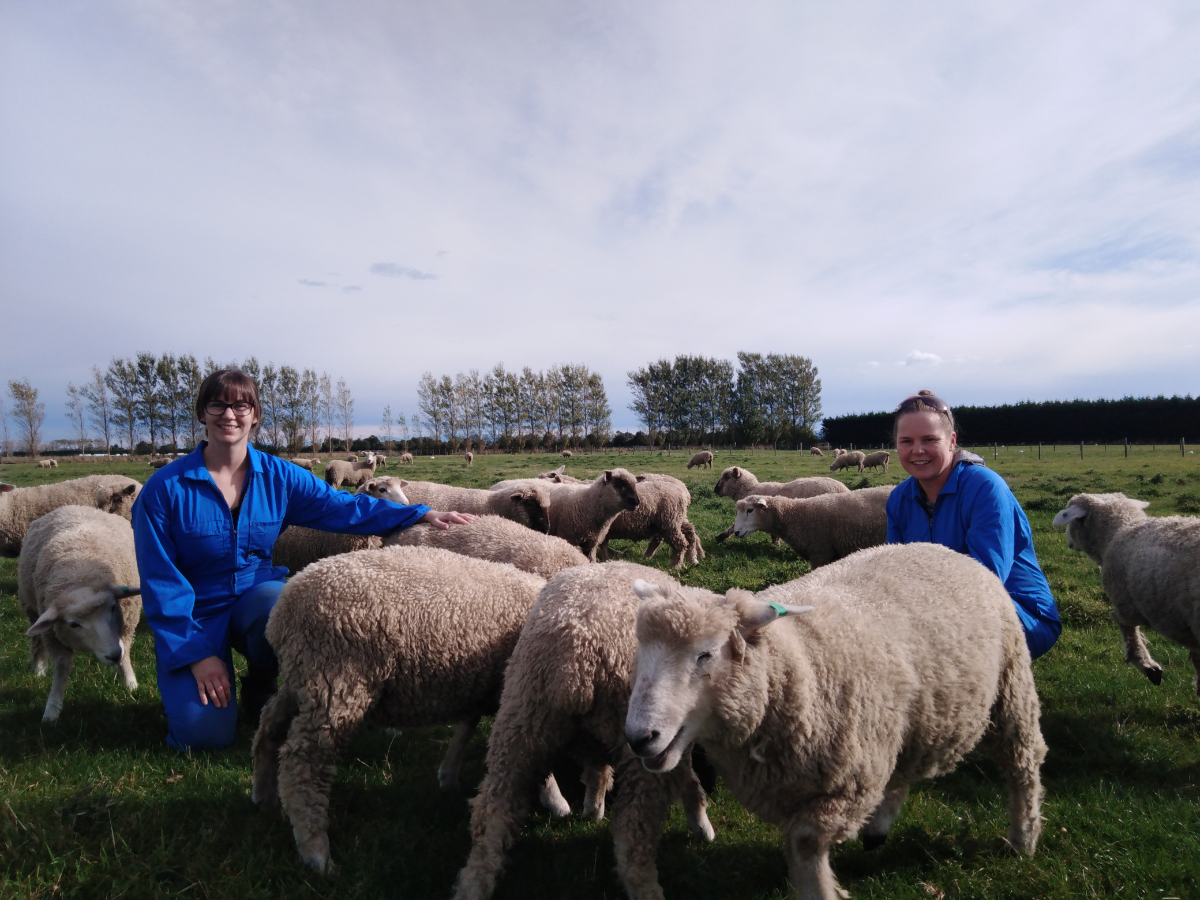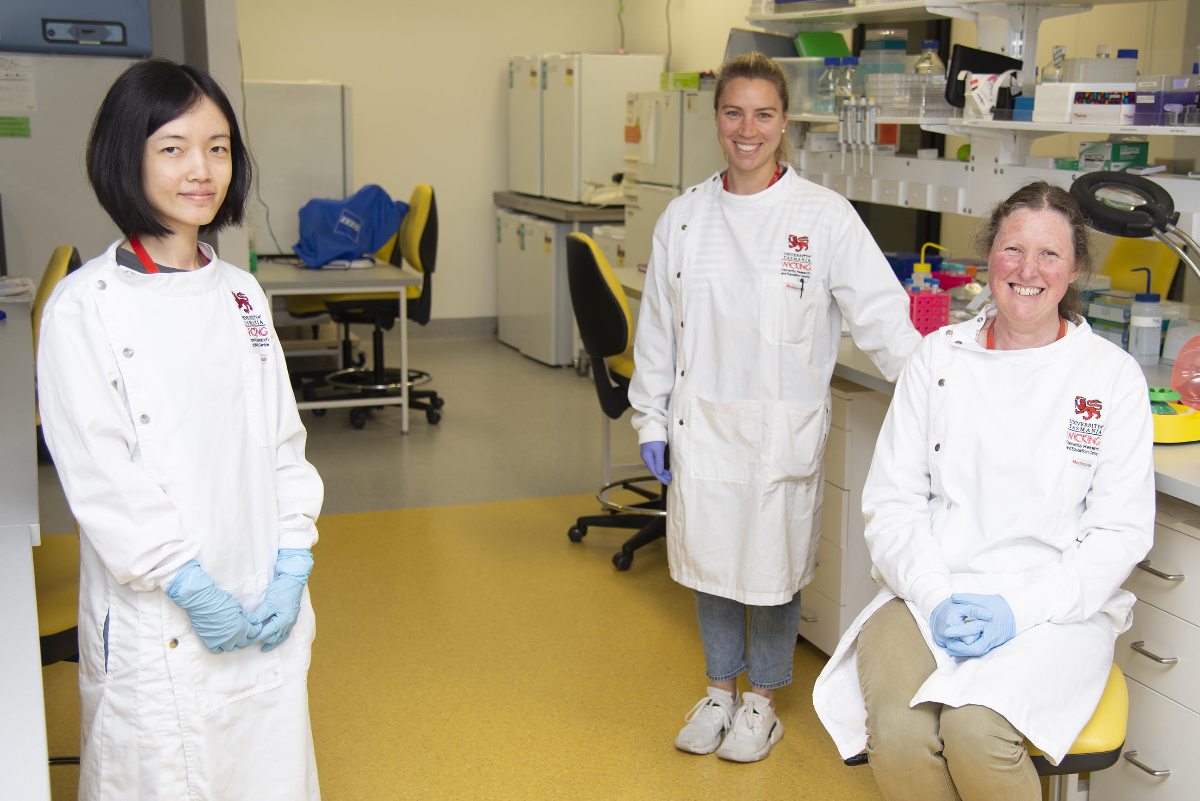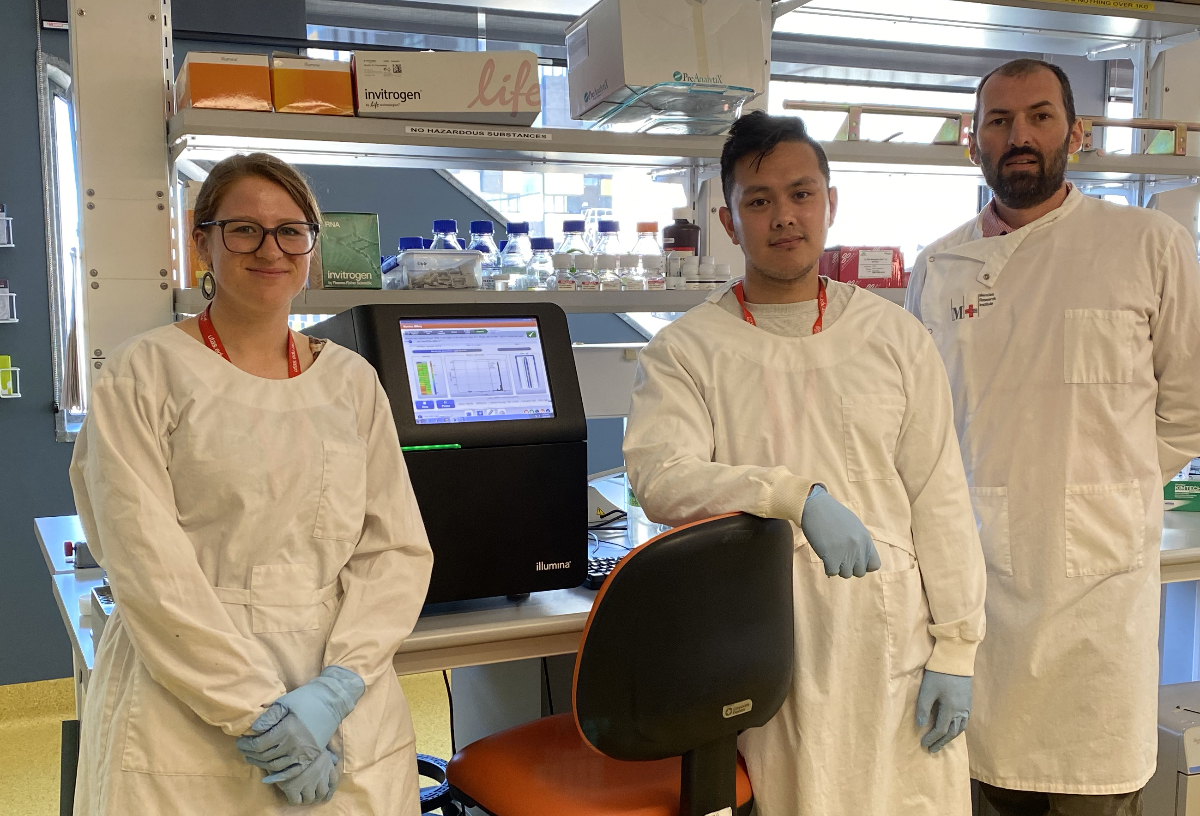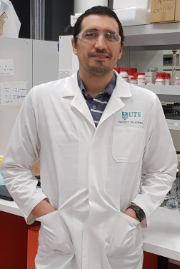| Chief Investigator: | Associate Associate Professor Anthony Cook |
| Location: | Wicking Dementia Research and Education Centre, University of Tasmania |
| Grant: | $AU 53,612 (co-funded with Beyond Batten Disease Foundation) |
| Duration: | 1 year |

CLN3 disease affects the brain of children, causing dementia and premature death. Whilst we know that >70 pathological variants in the CLN3 gene cause disease, we know surprisingly little about the processes that occur cells in the eye and brain to become dysfunctional and die. Furthermore, most of what we do know is derived from studying mouse models of CLN3 disease that model the commonly occurring 1 kb deletion CLN3 variant. Thus, for many people with CLN3 disease, there is little, or even no data relevant to the CLN3 variants causing their disease.
This project seeks to overcome this lack of data, through generating a powerful and unique resource with which to study CLN3 disease. We will use advanced techniques in stem cell biology and gene editing technology to produce a collection of stem cell lines that will enable us to begin determining how CLN3 gene variants that have different effects on the CLN3 protein, or which are associated with “Classic” or “Protracted” clinical descriptions of the disease.
This stem cell collection represents the first step in larger subsequent studies focused on understanding how different CLN3 gene variants change the function of cells in the eye and the brain. Through sharing the stem cell collection widely with other researchers, this project will provide a means to better understand the disease and in turn, identify and test new treatment strategies.
BDSRA Australia wishes to thank the Beyond Batten Disease Foundation for partnering with us to co-fund 50% of this grant.

| Chief Investigator: | Dr Nadia Mitchell |
| Location: | Faculty of Agriculture and Life Sciences, Lincoln University, NZ |
| Grant: | $AU 54,545 |
| Duration: | 1 year |

Gene therapies developed in naturally occurring sheep models of CLN5 and CLN6 Batten disease at Lincoln University (NZ) look encouraging. In particular, the single delivery of our CLN5 gene therapy product to the fluid-filled spaces (lateral ventricles) in the brain of affected sheep protected against neurological disease and brain shrinkage. In addition, delivery into the jelly-like fluid of the eye (vitreous humour) protected against vision loss. Based on these studies, our CLN5 gene therapy was recently approved for use in children with CLN5 Batten disease (Clinicaltrials.gov identifier: NCT05228145).
As we potentially begin to treat the neurological disease and loss of vision in Batten disease, we need to consider the impact of the disease on the other peripheral organs. The disease-causing mutation is present in all cells of the body and the Batten disease proteins are expressed across the periphery, including the heart, lungs, liver, pancreas, kidneys, gastrointestinal tract, muscle, endocrine tissues, and reproductive organs. With the prospect of treated children living longer without neurological disease, we need to pre-empt what may come next and be prepared to treat, or ideally prevent, disease in the periphery.
This study will examine disease pathology in peripheral tissues, such as those listed above, from healthy, affected and treated sheep of different ages. Overall, we aim to understand how peripheral pathology manifests, if at all, within the normal lifespan of affected sheep, but also determine if peripheral pathologies may be unmasked in our treated sheep with much longer than expected life spans. Concurrently we will examine haematology, biochemistry, and inflammatory markers in blood from healthy, affected and treated sheep to look for any potential biomarkers, which is severely lacking in human NCL medicine.
| Chief Investigator: | Lottie Morison |
| Location: | Murdoch Children's Research Institute |
| Grant: | $AU 13,950 |
| Duration: | 1 year |


This research proposes to phenotype speech and language in Batten Disease (CLN2 and CLN3 subtypes) for the first time. In all forms of neuronal ceroid lipofuscinoses (NCLs), or Batten Disease, symptoms may include a decline in motor skills, cognition and vision, epilepsy, sleep difficulties, psychiatric symptoms and deteriorating speech and language. Phenotyping these symptoms is valuable to measure disease progression and the efficacy of precision medicine trials. Clinical trials are being conducted to investigate the efficacy of treatments, including enzyme replacement, stem cell and adeno-associated virus-mediated gene therapies.
Although progressive speech and language impairment is implicated in all forms of Batten Disease, there has been no systematic characterisation of speech and language. Phenotyping informs the implementation of clinical trials. Speech and language characterisation provides a window into the neurobiology of Batten Disease. It will help inform families and clinicians’ decision making as a child’s speech progresses from using speech to using Augmentative and Alternative Communication to communicate.
This research has three specific aims:
*Note, if you are a parent or guardian of a child with Batten disease (in Australia or New Zealand) and would like to know more about being involved in this study, please contact BDSRA Australia at research@bdsraaustralia.org.
| Chief Investigator: | Associate Professor Anthony White |
| Location: | QIMR Berghofer Medical Research Institute QLD |
| Grant: | $AU 49,600 |
| Duration: | 1 year |




Developing drugs to treat brain diseases is a very slow and costly process, often taking 10-15 years and billions of dollars. Yet, the success rate is also very low, with only 1-2% of drugs actually end up being used to treat patients. A major part of this slow and complex process is all the early safety analysis and determining if the drug can actually penetrate into the brain. To help overcome the slow delivery of drugs to patients with rarer diseases, drug-repositioning can be investigated. This is where drugs that are already in use in the clinic for other diseases are investigated for their ability to work on another disease i.e. Batten disease. If a drug is found to be suitable, it has a far quicker path to use for Batten disease patients, as the drug has already passed the initial development stages and is used by other patients.
Although the testing of clinically-approved drugs can be done randomly, there are many thousands of drugs to test and this is a costly and high risk, low outcome approach. Instead, we propose to use computer-based algorithms that analyse the gene pathways involved in Batten disease and compare this to known drug action on these pathways. In this manner, we anticipate that we can identify drugs (that are already in the clinic for other diseases) which may be able to target specific key genes/proteins in Batten disease. To confirm this, we will select several of these identified drugs and test them on cell models of Batten disease in the laboratory to determine how they affect the cells. The outcomes from this will potentially provide a rapid pathway for identifying drugs that could then be tested in advanced clinical trials on Batten disease patients.
| Chief Investigator: | Associate Professor Anthony Cook |
| Location: | Wicking Dementia Research and Education Centre, University of Tasmania |
| Grant: | $AU 55,000 |
| Duration: | 1 year |

The blood-brain barrier (BBB) is a specialized part of our bodies that separates our blood supply from our brain. The BBB controls the delivery of oxygen and energy into the brain to keep it functioning and healthy. When the BBB breaks down, the cells of the brain are starved of energy and can no longer function normally. While we know that the BBB is involved in Batten disease, we do not fully understand how this occurs. Variation of the CLN3 gene occurs in Batten disease and our goal is to determine how the BBB is affected by variants in the CLN3 gene. To do this, we have used advanced techniques in human stem cell biology and gene editing technology to develop a new human cell-based model of Batten Disease.
Such models are needed to accelerate moving laboratory findings into effective and safe treatment options for people with this disease. We can turn these stem cells into the cell types that form the BBB, and we will study how CLN3 gene variants change the normal function of these cells. We will identify molecules that explain these changes, and which may be suitable targets for development of new therapeutics. We will also develop techniques to re-construct the BBB in the laboratory, which will allow us to study this structure in greater detail; this is important because getting drugs to cross the BBB is a significant bottleneck to finding new drugs to treat diseases affecting the brain. Thus, we will provide a platform for testing how and if new drugs are able to enter the brain, and thereby accelerate development of treatment options for people living with Batten disease.
| Chief Investigator: | Associate Professor Anthony Cook |
| Location: | Wicking Dementia Research and Education Centre, University of Tasmania |
| Grant: | $AU 49,400 |
| Duration: | 1 year |

Our goal is to identify new drugs to treat Batten disease caused by variants in the CLN3 gene. To do this, we have used advanced techniques in human stem cell biology and gene editing technology to develop a new human cell-based model of Batten Disease. Such models are needed to accelerate moving laboratory findings into effective and safe treatment options for people with this disease. Preliminary investigations with this new model indicate that when the stem cells are maturated in the laboratory into nerve cells, those cells with Batten disease CLN3 gene variants reveal changes in how these cells communicate with one another, as well as changes in structures within the cells involved in energy production or in degradation of proteins. These changes are consistent with what is known about Batten Disease from the study of human tissue sample and from animal models.
In this project, we will extend these preliminary findings to determine their robustness, and investigate further how it may be that CLN3 variants affect these features of nerve cells. Based on these findings, we plan to test over 350 drugs that are known to be activate in the brain for their ability to affect how cells with Batten Disease CLN3 variants function. This project will initiate a new program of research focused on determining the suitability of such drugs as new treatments for Batten disease.
| Chief Investigator: | Professor Alex Hewitt |
| Location: | Menzies Institute for Medical Research, University of Tasmania |
| Grant: | $AU 50,000 |
| Duration: | 1 year |

Heralded as the most significant breakthrough in biology since PCR (a process developed in the early 1980’s that enables the amplification of DNA), the adaptation of the “CRISPR/Cas” system to mammalian cells is set to revolutionise treatments for inherited disease. The CRISPR/Cas system, used by bacteria to counter viral intrusion (somewhat akin to our adaptive immune system), can cut or edit DNA at specific sites. The clinical application of CRISPR/Cas technology opens the very real prospect of anticipatory cures to well-defined inherited diseases. We have engineered a novel enzyme, which essentially hides a gene editor inside the larger CRISPR/Cas enzyme. With this protein design we have found an improved on-target editing efficiency, and a reduced off-target footprint. As such, this protein appears more effective and safer. Additionally, it is small enough that it can be adequately packaged into an adeno-associated virus, thereby facilitating robust delivery to target cells. We now seek support to determine if this novel gene editing therapy can be directed to correct a disease-causing variant in a preclinical model of CLN2-related disease. This project opens the door to therapeutic gene editing and a definitive cure for Batten Disease.
| Chief Investigator: | Dr Nadia Mitchell |
| Location: | Department of Wine, Food and Molecular Biosciences, Lincoln University, NZ |
| Grant: | $AU 56,440 |
| Duration: | 1 year |

Naturally occurring ovine (sheep) models of CLN5 and CLN6 Batten disease are well established at Lincoln University (NZ). We are developing gene therapies in these sheep models which are yielding encouraging results for translation to humans. Sheep have large human-like brains and disease progression in them closely follows that in affected children. We have shown that the single administration of CLN5 gene therapy to the fluid-filled spaces in the brain (the lateral ventricles) protects against stereotypical disease and brain atrophy. Treated sheep are still alive up to five years post-injection, three times longer than their natural life expectancy. We found that delivery of CLN5 gene therapy to the jelly-like fluid of the eye (the vitreous humour) also protected against visual loss.
This led us to test combined brain- and eye-directed gene therapy at different stages of CLN5 disease. Even when given at an advanced symptomatic stage, high doses of gene therapy halted disease progression, stopped brain atrophy and slowed visual loss. We are preparing these results for an Investigational New Drug application to the US Food and Drug Administration, with the aim to start the first CLN5 gene therapy clinical trial in humans next year. However, it will be important to test the equivalent doses and delivery routes in sheep in parallel with this clinical trial and to see if there are any long-term negative effects of the therapy. This project will undertake research to address these important questions. Additionally, we want to get a better understanding of the pathological changes in the brain, eye and spinal cord of affected sheep over the disease course, in order to provide robust, accurate data for translation to humans.
| Chief Investigators: | Associate Professor Ronald Clarke and Dr Alvaro Garcia |
| Location: | School of Chemistry, University of Sydney and School of Life Sciences, University of Technology, Sydney |
| Grant: | $AU 21,256 |
| Duration: | 1 year |


The CLN3 form of Batten disease is known to be due to a mutation in the CLN3 protein (also known as Battenin) which is located within an intracellular membrane. Recent research on mice which are deficient in the CLN3 protein has shown that the symptoms of their disease are alleviated by the small molecules carbenoloxolone, enoxolone, prednisolone and 7-ketocholesterol. Each of the molecules are steroid- or sterol-like, i.e., similar in structure and chemical behaviour to cholesterol. Although cholesterol is often associated with heart disease, it is a major constituent of animal cell membranes, where it plays an important beneficial role in optimizing the function of vital membrane proteins, including that of the sodium pump, whose activity controls cell volume. Considering the membrane location of CLN3 and the cholesterol-like structures of the molecules found to improve Batten disease symptoms, it appears highly likely that these molecules exert their effect through the membrane, either the membrane directly surrounding the CLN3 protein or a membrane located elsewhere in the cell. The aim of our proposed research is to explore this hypothesis and discover the role that membranes have in influencing the symptoms suffered by Batten’s disease sufferers.
Our research will use a combination of experimental and theoretical approaches to determine the effect of each molecule on electrical properties of membrane, membrane fluidity, the chemical forces within the membrane and both the location and orientation of each molecule within the membrane. By comparing the effect of each molecule on each of these properties with their known effects on Batten disease symptoms in mice, we will discover which membrane property needs to be modified in order to alleviate the symptoms of the disease. As well as investigating the lipid (or fat) component of the cell membranes, we will also study the effect that each molecule has on the model membrane protein, the sodium pump, which also plays a key role in the healthy function of nerve and muscle cells, i.e., cells which are particularly vulnerable in Batten disease. Our research thus represents a fundamental scientific study which will provide a rational foundation on which the design of improved drugs for the treatment of the CLN3 form of Batten disease can be based.